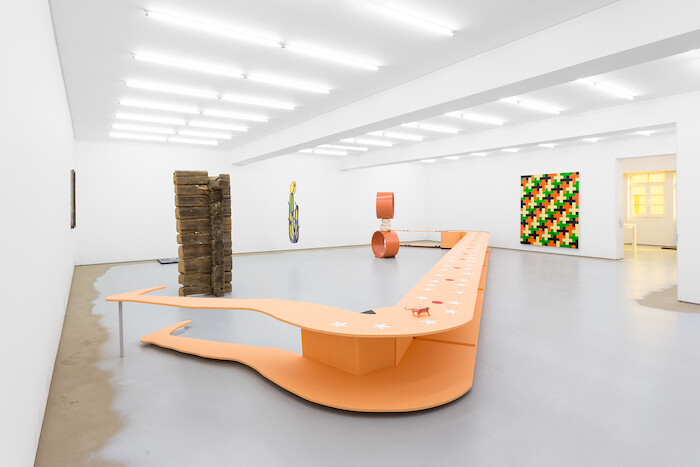Seclusion, misanthropy, and asceticism came to my mind when I first saw the title of curator Samuel Leuenberger’s group show at Galeria Vera Cortês, featuring the work of four international artists. Contrary to my initial belief, however, the hermit crab does not get its name from being a loner but by virtue of its appropriation of empty shells to protect the soft parts of its body. Dragging its makeshift armor along as its body grows, there are times when the hermit crab requires a bigger, safer, better shell—the kind of strategy and necessity on which many of the routines, expectations, and symbolic exchanges of capitalist societies are based.
The arrangement of works in Vera Cortês’s otherwise sparsely occupied gallery results in a feeling of congestion. Four meters in length, Teresa Solar’s Nut (2018) is primarily responsible for this effect. Based on the stylization of a nude elongated female figure lying on one side, painted pale orange, and decorated in star-shaped circus patterns, it draws a diagonal line through the middle of the gallery’s main room, establishing a barrier that is both physical and conceptual. The pieces distributed on either side of this body-come-bench form two distinct constellations: clean-cut, allegorical, two-dimensional on one side, and organic, symbolic, three-dimensional on the other.
The former half is dominated by works by Jan Kiefer. In the first, three canvases from 2018 display variations of patterns based on the crucifix, a formal effect that nods to the pictorial tradition of Pattern and Decoration and forces a symbolic erosion of the cross through derisory repetition. In the second, two immaculate display cases—Untitled (Bluesecco) (2018) and Untitled (Perfume) (2017)—exhibit assortments of advertisements, consumer goods, and origami made from euro banknotes. As if attempting to fuse Joseph Cornell’s vernacular assemblages of with the industrial austerity of Donald Judd’s work, these boxes are portraits of a raw, aseptic, and over-designed everyday life, fictions of a romantic inversion in which everything is equal because everything is simultaneously too familiar and too distant—devitalized and lacking in density.
A strip of brownish powder, roughly 30 centimeters wide and placed on the perimeter of the floor of the main room, suggests a psychological dimension of constricted space: outline as a circumscription and limit more than formal expression. The powder is part of Dora Budor’s installation The Preserving Machine – Notes From the Environment (2018). The second element of the work takes the form of an eternal sunset created by the application of orange window gels to all the windows in the office space adjacent to the main gallery. This transition between exterior and interior—a nod, perhaps, to the tension between containment and growth alluded to by the show’s title—is complemented by A Certain Hazy Condition (2018), an edition of posters, taken from Budor’s series “When the Sick Rule the World,” displayed in piles in the exhibition space and put up in various locations around the gallery’s neighborhood. The posters feature a woman wearing prosthetic makeup. Depending on how the observer views the image, she’ll seem to have a face too old for her body or a body too young for her face. Budor’s interest in the techniques, props, and diegetic strategies of cinema is well established. However, the appropriation of the title of Dodie Bellamy’s 2015 book for this series not only places Budor’s references in the narrower cultural context of experimental literature, but also seems to have steered her apparent fascination with the possibilities of professional make-up effects to the creation of images that offer overly literal and sterile approaches to Bellamy’s complex imaginary
The contrast between the pair of large, hollow industrial cylinders in Solar’s Pipeline: Junction (2018) and the amorphous shape of the junction itself sets the tone for the dialogues taking place in the second half of the show. While natural elements—such as the dark wood used in Augustas Serapinas’s Corner from Matukai and October 21st (both 2018) or the titular plant of Jan Kiefer’s stained glass Cactus (2017)—connect the various works, their relations are equally reinforced by the absences they signal: the absence of utility in Solar’s Pipeline, the disappearance of a rural building tradition in Serapinas’s appropriation of salvaged materials, or the lack of any lighting effect in Kiefer’s stained glass.
At the end of this unfolding, interconnected exhibition, the figure of the hermit crab is subsumed beneath layers of meaning and reference. But then I notice Solar’s Tiger (2018) standing at one end of Nut: a discreet, plastic sculpture of the feline, its body cut in half and extended by pink plasticine. Its dissected and extruded body is the reverse of a simulacrum: a substance without image; the soft part of a body with neither skin nor armor; the excrescent mass of a collective, irrepressible impulse towards (self-)expansion; and the everlasting ambition of becoming bigger, safer, better.









